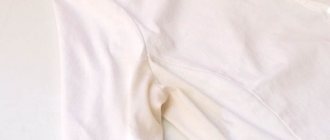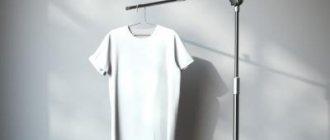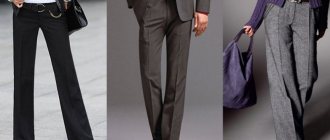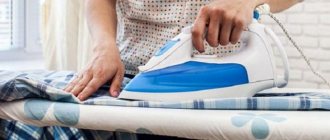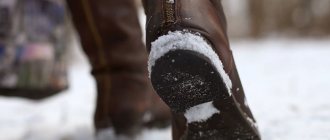Shirts are an everyday part of the wardrobe of office workers. To look neat and well-groomed every day, you need to know how to properly iron a shirt. Ironing business items requires a special approach.
Our article with video describes a step-by-step ironing algorithm and provides useful tips and recommendations. By following the instructions, you can iron your item flawlessly without leaving a single crease.
What will you need?
It is impossible to iron a shirt without special equipment. Therefore, before you start ironing the product, you need to prepare the following:
- iron with steamer. If this function is not available, you can use a spray bottle with water. It is important that the base of the device is clean, free of soot, scale and rust. A dirty iron can ruin a shirt, especially a light-colored one.
- ironing board with cover. An additional advantage will be the ability to adjust its height. If you can’t use the board, you can replace it with a flat table covered with a light, dense fabric without a pattern.
- stand for ironing sleeves of shirts and sweaters. It usually looks like a small ironing board and comes with it. This is not a necessary device, but it will make ironing sleeves and cuffs much easier, faster and with better quality.
- ironing spray. These products can be bought at a household chemical store or made independently from available ingredients (a solution of 1 tablespoon of starch in 1 liter of water). Thanks to them, the ironing effect lasts much longer, and the process itself becomes easier.
- vertical steamer. They can easily smooth out wrinkles and bruises without the risk of burning the product.
- office clips. It is not necessary to use them. Clips will help to secure the sleeves evenly if you need to make arrows on them.
You will also need a little patience and free time. You cannot rush in this matter, because there is a risk of ironing the shirt poorly or burning it.
Alternatives
For most housewives, ironing is associated exclusively with the iron, which every family has.
However, progress does not stand still, and today in the household appliances market you can find many alternatives to a conventional iron, which can greatly simplify life.
These alternative options include:
- steamers,
- steam generators,
- ironing mannequins.
Steamer
One such alternative is a steamer. A high-quality steamer will cost at least 15 thousand rubles, simpler models can be purchased for 10 thousand rubles. A manual steamer can be purchased for a more modest amount - from 2 thousand rubles.
Its advantages include:
- more gentle effect on fabric;
- high speed ironing;
- can disinfect things with steam;
- It is impossible to burn or damage the item with a steamer.
Disadvantages of the steamer:
- high price;
- the device is quite large in size (if it is not a manual version);
- In any case, you will have to iron the small details of the shirt: collar, cuffs.
Steam generator
Another alternative option for manual ironing is a home steam generator. Their prices vary from 5 to 40 thousand rubles. (depending on the brand and power of the model).
The advantages of a steam generator include:
- You can iron thick fabrics and even folded items quickly and efficiently;
- ironing with such a device is quick and efficient thanks to the large amount of steam;
- fabrics retain their original appearance longer.
Disadvantages of the steam generator:
- you need a place to store it;
- the device is quite noisy;
- steam generators are not cordless.
Dummy
The most expensive alternative to an iron is an ironing dummy.
A household appliance costs at least 70 tr, and the price for a professional model reaches 200 tr.
You can iron a shirt using such a device very quickly, however, due to the high cost and large size of the device, this is not the most popular “replacement” for an iron.
Read about special machines for ironing shirts in this article.
Preparing the Shirt
A few tips to help you prepare your shirt for ironing and achieve a quality result:
- wash the shirt and remove all stains, otherwise the dirt will penetrate even deeper into the structure of the fabric under the influence of temperature. Then it will be almost impossible to remove them.
- It is best to dry your shirt on hangers, this way it will retain its shape and wrinkle less. You need to fasten all the buttons, straighten the cuffs and collar. If you hang the product to dry on a rope or radiator, folds will form on it; ironing it will take more effort and time.
- if the product is completely dry, spray it with distilled water from a spray bottle. But it is best to iron a slightly damp shirt that is not completely dry.
- Silk, especially artificial silk, cannot be ironed with steaming; only dry ironing is allowed from the reverse side.
- Delicate materials should be ironed through chintz or satin fabric; gauze and waffle towels should not be used as lining - they may leave marks.
- trim all protruding threads and remove lint. The most convenient way to do this is with a roller for cleaning clothes. This way, dust will not stick to the iron.
- Turn items with any accessories, embroidery, or convex pattern inside out. The soleplate of the iron can be damaged if you run it over such decor.
- read the instructions carefully. The label indicates all the necessary information about caring for the item, including the mode in which it should be ironed.
Temperature selection depending on fabric type
People don’t always save tags from clothes, because they can cause unpleasant sensations when worn: pricking, tickling, and if the shirt is see-through, it can also spoil the appearance.
In this case, the heating mode of the iron is determined by the type of fabric:
- 100% cotton. This material is quite dense and durable, so you can iron a cotton shirt at temperatures up to 200°C. The optimal mode is two, but if you can’t iron the fabric, it is recommended to turn on the three. On most modern models of irons, next to the dots indicating the main modes, there are additional inscriptions: you can iron a cotton shirt in the “cotton” mode;
- cotton fabrics with impurities. Usually they are allowed to be ironed in pairs. However, the temperature depends on the material mixed with the cotton. Thus, flannel shirts can be ironed at 110°C, jacquard - at 130-140°C;
- denim is especially popular in informal clothing styles. You can iron it on a two-piece, if the material is thick enough - on a three-piece. Before the procedure, the denim product must be turned inside out and moistened generously with water - this will prevent the appearance of faded areas;
- viscose. Women's shirts are usually made from this lightweight material. Viscose should be ironed single or double, at a temperature of 120°C;
- linen, like cotton, is resistant to high temperatures, so it can be ironed on a triple iron;
- Poplin is what shirts for everyday wear are most often made from. This dense fabric can be ironed on a double iron, at a temperature of about 120°C.
- Oxford is a dense synthetic fabric that can be ironed at a temperature of no more than 110°-120°C, that is, at one.
- silk is a fabric that is very capricious and short-lived, not suitable for everyday wear. Silk shirts can be ironed from the reverse side on the single or “silk” mode - at a temperature of about 100°C, without using a steamer.
Attention! If it was not possible to determine the type of fabric, it is better not to risk it and iron the product on one piece. If your clothes are not ironing well, increase the temperature slightly. If the fabric begins to slow down the iron, you must immediately turn down the setting. It may take more time and effort, but the shirt will remain intact. The denser the fabric, the higher the temperature should be.
Basic recommendations
Before you start ironing, be sure to study the recommendations on the product label . An iron icon with one circle inside means that the fabric needs to be processed at a minimum temperature, two circles correspond to the average temperature, and three circles correspond to the maximum.
Remember that when ironing silk or synthetic items, it is recommended to refrain from using steam and use the most delicate setting. It is best to turn the shirt inside out and only then begin processing. The same applies to any dark fabric, on which shiny marks may appear on the front side when ironed.
You can purchase clothes from famous brands at low prices in the online store https://barbaru.ru/
Cotton clothing can be exposed to high temperatures and even steam shock. Linen fabric can be ironed at maximum speed and steam can also be used.
You can always find ironing recommendations on the labels
Experts do not recommend drying clothes with an iron - this causes significant stress to the fabric fibers and is damaged. Therefore, it is better to dry the shirt before ironing or leave it slightly damp. You can always wet the fabric using a water spray or selecting the steam mode.
Of course, the most convenient way to use an iron is on a special ironing board. Large boards often come with miniature ones, which are convenient to use for ironing long sleeves without creases.
To spend less time ironing, you need to make sure that the shirt does not wrinkle during drying. It’s best to hang your clothes on hangers after washing, so you don’t have to think about how to deal with creases.
How to iron a long sleeve shirt?
In order for the product to look neat, it must be ironed correctly, without missing a single detail. Ironing long-sleeve shirts is a little more difficult and takes longer than short-sleeve shirts.
There is a certain procedure that will allow you to iron a men's long-sleeved shirt with high quality without missing a single detail.
Collar
The first step is to iron the smallest detail - the collar. If you iron most of the piece first, it will wrinkle while the rest of the pieces are ironed.
You need to iron your shirt collar as follows:
- If possible, remove the seeds.
- Stretch the piece on an ironing board; there should be no wrinkles.
- Iron from the edges to the middle on the front side.
- Fold the edges of the collar inward so that it stands up.
- If the part should not be standing, it can be ironed along the fold in the middle.
Sleeves and cuffs
After the collar, you need to iron the sleeves and cuffs of the shirt.
Ironing shirt sleeves is quite difficult because they easily lose their shape. To iron them efficiently, you need to adhere to the following algorithm:
- Pull the bottom seam to ensure there are as few wrinkles as possible on the garment. If you have a stand, iron the sleeve by pulling it over the fixture.
- Iron the cuffs on both sides: from the inside and from the face. The area of fabric near the buttons must be ironed especially carefully so that the iron does not touch them.
- After securing the sleeve with a paper clip, iron it from the front. You need to move the iron in the direction from the center to the edge, very carefully, without sudden jerks. Otherwise, the fabric may move and new folds will appear on it.
- Repeat the same on the reverse side.
- Make arrows if desired. To do this, you need to apply the iron several times for 2-3 seconds to the place where the crease should be.
Attention! Cuffs, like the collar, should not be ironed at high temperatures, otherwise they will lose their shape.
Front and back
After the sleeves and cuffs, you need to iron the front and back of the shirt.
The side with the buttons is processed first. To do this you need:
- Straighten the unbuttoned shirt on the ironing board.
- Remove the sleeves so that they do not interfere.
- Iron the shelf with buttons from top to bottom.
- Particular attention should be paid to the part under the collar, as it is clearly visible. Iron the fabric carefully around the buttons; if you touch them with the iron, they may melt.
The next stage is the easiest - ironing the back. There is usually no decor or buttons on this side, so the procedure does not require special care. It is necessary to straighten the shirt well on the board, iron it, moving from top to bottom.
Attention! If there is a label or patch on the back, there is no need to iron it. They are usually made of synthetics, which can melt slightly and prick your neck when you wear the product.
Next, move to the side without buttons. You need to iron it the same way as the side with buttons.
Shoulders
Processing the hangers is the last step necessary to obtain the perfect result - an ironed shirt.
Procedure:
- Pull the top of the shirt onto the narrow part of the board so that the product is as straight as possible.
- Use the tip of the iron to stroke all hard-to-reach areas. This must be done very carefully, starting from the narrowest places, so as not to wrinkle the part you just ironed.
- Repeat the same with the other shoulder.
Advice! To avoid creases, place a folded terry towel under your shoulder and iron on it.
Before putting the product in the closet, you should carefully inspect it. If there are wrinkles or unnecessary folds, iron these areas again.
Important nuances
There are a few additional points to consider:
- After washing, the shirts are thoroughly shaken, straightened, and dried on hangers, with the collar in its natural position and the sleeves stretched out without wrinkles.
- If ironing is not possible right away, the shirts are carefully folded so that the collar and cuffs do not wrinkle - they are the most difficult to iron.
- Ironing sleeves is the longest and most difficult. If the shirt is worn only under a jacket, you can leave the arrows. In any case, the cuffs are brought to perfect condition.
- It is better to iron dark shirts from the inside out so that there is no shine or tarnish left.
Embroideries and labels are ironed carefully, through the fabric, from the wrong side. It is better not to touch them with a very hot iron.
How to iron a short sleeve shirt?
Ironing items with short sleeves is a little easier than with long sleeves. However, here too there are some nuances and rules, the observance of which will allow you to look stylish and neat. Procedure:
- iron the back of the product;
- iron the front sides: first with buttons, then without;
- iron over the collar;
- iron the sleeves, folding them at the seams;
- arrows on short-sleeve shirts and blouses are considered a sign of poor taste, so they should be removed. This can be done using a folded thick lint-free cloth or towel. Place it in your sleeve and iron the folds.
How much does the home delivery service cost?
For single men and housewives who do not have time to iron shirts, a paid ironing service has been invented . You can give your shirts and other laundry to a cleaning company or invite your “wife for an hour” to your home.
for ironing shirts will cost from 500 rubles per hour of work. Cleaning agencies are ready to work for an amount of 200 rubles per hour, but you will have to bring and pick up things yourself.
The cost depends on the location of the agency (in the capital and large cities, services are more expensive) and the complexity of the work (the fabric from which the product is made).
How to iron shirt sleeves without arrows?
Not everyone likes the look of arrow sleeves. Ironing a piece of clothing so that creases do not appear on it can be done quite easily; you will need thick fabric.
Algorithm of actions:
- Iron the sleeves first from the wrong side, then from the front, without touching the seams and edges with the iron.
- Place the thick fabric inside the sleeve, iron it on both sides, repeat with the other.
- If arrows have already formed on the product, you can get rid of them by ironing them from the inside out.
Other ironing methods
Sometimes unforeseen circumstances arise in which it is not possible to iron clothes: a power outage or equipment breakdown.
In this case, you can remove the folds from the product using hot steam from water. However, you cannot steam a shirt over a pan on the stove. There is a risk that the product will become stained with grease. The best option is to run a bath of hot water and hang your shirt over it with the door closed.
You can also prepare a special solution, after using which you will not have to iron the item:
- mix vinegar, water and fabric softener;
- treat the shirt with the resulting solution;
- dry on hangers.
If you have an iron, but no ironing board, you can iron the shirt on a hard, large surface, for example, on a table. It is important that it is clean. You need to lay a blanket on the table, and on it a thick, light-colored fabric, for example, cotton or linen.
Shirts that do not require ironing
Many manufacturers produce shirts that do not need to be ironed. They are well suited for those who do not want to waste time on ironing or are constantly late. However, shirts that do not require heat treatment also have disadvantages: a relatively short service life, the possibility of allergic reactions, and a less solid appearance. Shirt fabrics are made from 100% cotton or a cotton-polyester blend. To find out if a product needs to be ironed, look at the label. If it says “wash and go”, “non-iron”, “wash and wear”, “easy care” or the iron icon is crossed out, the fabric does not require heat treatment.
Among the many brands under which shirts that do not require ironing are produced, we can highlight:
- Brooks Brothers.
- Marks&Spencer.
- Lewin.
- Thomas Pink.
- Hugo Boss.
Useful tips
- To extend the life of your shirt, follow all recommendations contained in the instructions for the clothing.
- A freshly ironed shirt should not be put on immediately; it is better to let it hang and cool for 5-7 minutes.
- The more powerful the steamer on the iron, the easier it is to iron a shirt that is difficult to iron.
- Always let deodorant and perfume dry before putting on your shirt, otherwise they will leave residue.
- After wearing, hang the shirt on a hanger to prevent wrinkles and creases from forming on it.
If there is no iron
If you are away from home and do not have the opportunity to use an iron, but you need to look your best, you can use an old but effective secret .
To do this, the product must be placed as level and neatly as possible on a hanger and hung vertically in the bathroom while you take a shower.
Under the influence of steam, the fabric will straighten and all that remains is to dry the shirt at room temperature.
You can find out about other ways to iron a shirt without an iron here.


